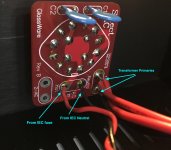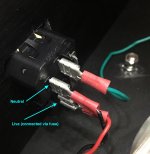in case of BadaBoom , it's weaker than effect on mains fuse
pony up for NTC
badaboom ? what would be the worst scenario that would justify such a decision
Lightning surge via ground?
Hello,
Grounding with a simple resistor 10 Ohm of maybe 1 W or less might be cheaper than a CL60 if i might suggest.
No inrush there to suppress.
I'm always up for cost savings, but I already purchased the CL60 awhile ago, so might as well use it! Thanks for the suggestion, though.
in case of BadaBoom , it's weaker than effect on mains fuse
pony up for NTC
As I recall, ZM, I think the post I ready about the virtues of the CL60 was yours. I have ponied up! Just need to wire it in place now. Hopefully this evening...
Related to Hikari's AC concern,
Please ensure that you wire the live side of the AC wall outlet to the live side of the IEC.
As I understand it, and PLEASE, do not think I am an expert:
When the fuse blows, it's supposed to disconnect the live conductor from the amp circuit, not the neutral. If you fuse the neutral side, the live AC is still live after the fuse blows.
Live and neutral can be reversed if you make your own power cables -- so be careful!
Please ensure that you wire the live side of the AC wall outlet to the live side of the IEC.
As I understand it, and PLEASE, do not think I am an expert:
When the fuse blows, it's supposed to disconnect the live conductor from the amp circuit, not the neutral. If you fuse the neutral side, the live AC is still live after the fuse blows.
Live and neutral can be reversed if you make your own power cables -- so be careful!
Last edited:
Related to Hikari's AC concern,
Please ensure that you wire the live side of the AC wall outlet to the live side of the IEC.
As I understand it, and PLEASE, do not think I am an expert:
When the fuse blows, it's supposed to disconnect the live conductor from the amp circuit, not the neutral. If you fuse the neutral side, the live AC is still live after the fuse blows.
Live and neutral can be reversed if you make your own power cables -- so be careful!
Thanks, BigE. Hikari's comment made me look more closely, and I think I have it wired correctly. Attached is a closeup of the AC switch and IEC socket wiring. Of course, I might have all wrong, too!
Attachments

in rgis picture the WIRE CARRYING signal is single wire that is shielded, the wire is connected to the center of the RCA connector and the shield it connected to the other terminal.
is this correct? in my phono build, i used a shielded wire that has two separate conductors in it other than the shield. the two wires are connected to the RCA connector and the shield is not connected to anything/ which is correct?
In the case of coax wire (one wire/one shield) the center conductor carries the signal and the shield carries ground and acts as the shield.
For Twinax (2 conductors + separate shield) one conductor carries signal, one carries ground and the shield can be left floating (like in your phono amp) but the shield is usually connected at one end to ground so it can drain into the PSU ground. The shield can also be connected to ground at both ends but this is usually not done.
For Twinax (2 conductors + separate shield) one conductor carries signal, one carries ground and the shield can be left floating (like in your phono amp) but the shield is usually connected at one end to ground so it can drain into the PSU ground. The shield can also be connected to ground at both ends but this is usually not done.
Power supply ground to chassis earth.
What if a ground loop breaker is in place?
This is an interesting topic - the Pearl 2 PS uses a bridge rectifier, and the article by Wayne says you can also "connect chassis to circuit ground with a resistor, capacitor, or wire". The F5 uses a thermister between PS ground and chassis. My current BA-3 has no connection from PS ground to chassis.
Isolate ground from the chassis any way you want...with consideration that the energy of the transformer can go to ground. That's why we would choose a thermistor or diode bridge instead of a resistor in higher powered circuits.
But really, it's probably safest to assume AC line voltage is the worst case scenario for the ground loop breaker. Which means a resistor is not the best option.
No PSU to chassis connection at all (floating) has safety ramifications as there can be no connection to chassis and safety 3rd prong on power cord.
But really, it's probably safest to assume AC line voltage is the worst case scenario for the ground loop breaker. Which means a resistor is not the best option.
No PSU to chassis connection at all (floating) has safety ramifications as there can be no connection to chassis and safety 3rd prong on power cord.
What you are referring to as R12 is your DC offset. But you do not measure ACROSS R12. You measure after R12 and ground. Plus probe of your meter on output leg of R12 or input leg of C3 and negative meter on ground...you can use the ground pad of the PCB.
Okay, super newbie question here to round out Hikari1's helpful info in the above quote. When you all say measure "across" R10 and R11, does that mean place one probe on each leg of the respective resistors? And does it matter which side of the resistor the plus probe is on?
- Home
- Amplifiers
- Pass Labs
- The BA-3 as preamp build guide

